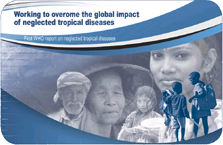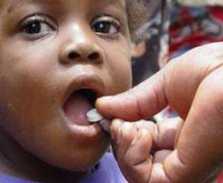Global NTD Programs
On This Page
Global Control Efforts
- Global Programme to Eliminate Lymphatic Filariasis
- African Programme for Onchocerciasis Control
- Onchocerciasis Elimination Program for the Americas
- Global Efforts to Control Schistosomiasis
- Global Efforts to Control Soil-transmitted Helminths (STH)
- Global Efforts to Control Trachoma
Global Eradication Efforts
- Guinea Worm Disease
United States Government Initiatives to Address NTDs
Global neglected tropical disease (NTD) programs focus on identifying regions and countries where NTDs are present and working to control or, when possible, eliminate them. CDC works within countries and through regional collaborations to help improve existing NTD interventions, such as mass drug administration (MDA) campaigns.
Global Programme to Eliminate Lymphatic Filariasis
The World Health Organization's Global Programme to Eliminate Lymphatic Filariasis (GPELF) was launched in 2000, with a target elimination date of 2020. GPELF aims to stop the spread of transmission and to lessen the severity of the disease in those already infected. In those areas suspected to have a high number of individuals at risk, anti-parasitic drugs (albendazole, donated by GlaxoSmithKline, plus either ivermectin, donated by Merck & Co. Inc., or diethylcarbamizine (DEC), donated by Eisai) are given to the entire population once a year for at least five years to help stop the spread of infection. Hygiene education efforts are also aimed at lessening the severity and number of leg infections in people with swollen legs, and have been particularly effective at decreasing the social stigma that is directed at some of the most severely affected persons.
To learn more about CDC's efforts to eliminate lymphatic filariasis in the Americas, please visit the Winnable Battles pages.

"For some of these diseases, evidence indicates that, when a certain threshold of population coverage is reached, transmission drops significantly; this raises the possibility that several of these ancient diseases could be eliminated by 2020 if current efforts to scale up interventions for preventive chemotherapy are increased."
-Dr. Margaret Chan, Director General, World Health Organization, taken from the First WHO report on Neglected Tropical Diseases
Related Links
Lymphatic Filariasis: Elimination in the Americas [PDF, 370 KB, 4 pages] Policy Brief: Lymphatic Filariasis [PDF, 275 KB, 2 pages]African Programme for Onchocerciasis Control
The African Programme for Onchocerciasis Control (APOC), created in 1995, has reduced the rates of river blindness by 73% since the program started. APOC's approach is treatment of individuals within the community with ivermectin (donated by Merck & Co., Inc), and is designed to enable local communities to distribute the drug quickly and independently. To date, 127,000 communities have participated in the program, 500,000 community drug distributors have been trained, and an estimated 78 million people are currently receiving treatment for the disease. Distribution of the drug though local channels has been an effective means of significantly reducing the impact of the disease in affected areas participating in the program.
Onchocerciasis Elimination Program for the Americas
The Onchocerciasis Elimination Program for the Americas (OEPA) is a regional initiative created in 1992, designed to reduce blindness and interrupt transmission of onchocerciasis in the 13 areas of six countries in the Americas where the disease still exists: Brazil, Colombia, Ecuador, Guatemala, Mexico and Venezuela. This program is a partnership that includes the six endemic countries, Pan American Health Organization (PAHO), Merck & Co., Inc., CDC, The Carter Center, Lions Clubs International Foundation, and CBM. The strategy employed by OEPA is to support ivermectin mass drug administration (MDA) twice per year, with the goal of reaching at least 85% of the more than 500,000 persons at-risk of the disease.
High treatment coverage has led to many successes, including the elimination of blindness in all 13 areas the disease was present, interruption of transmission in eight of the 13 areas, and suspected interruption in two additional areas. The most recent PAHO resolution in 2009 called for OEPA and its partners to interrupt transmission in the region by 2012. Surveillance and certification activities will follow; the year 2017 is the current target date for elimination of onchocerciasis in the Americas.
Global Efforts to Control Schistosomiasis
The burden of schistosomiasis in affected communities is generally measured by identifying areas where many school-aged children have blood in the urine or by doing stool exams. Depending on disease prevalence, the drug praziquantel (partially donated by Merck KGaA) is either given to the entire community or to school-aged children as a yearly dose. The medicine has been used to treat infection and to help reduce the seriousness of health effects, such as major organ damage, in individuals with long-term or repeat infections.

Drug being given to a child during a mass drug administration campaign.
Global Efforts to Control Soil-transmitted Helminths (STH)
In 2001, the World Health Organization (WHO) adopted a resolution aimed at the "deworming" of 75 percent of all at-risk school-age children by 2010 through distribution of the medications albendazole or mebendazole (donated by Johnson & Johnson). This is the largest public health program ever attempted to date. The program is currently underway and has been able to achieve some success in reducing the severity of worm infections in some areas. This is important progress, as infection with STH can lead to anemia, vitamin A deficiency, stunting, malnutrition, impaired development, and intestinal obstruction. Education efforts aimed at prevention though proper sanitation, hand washing, and food preparation are also critical to reducing spread of the disease.
Global Efforts to Control Trachoma
Trachoma is a bacterial infection of the eye, spread from person-to-person by direct contact. Untreated infection causes scarring of the upper eyelid that can lead to blindness; trachoma is the world’s leading cause of preventable blindness. Treatment for trachoma is focused on treating the symptoms and helping to prevent future infection. A major comprehensive public health strategy approved by the World Health Organization, called SAFE, is underway to treat trachoma epidemics in rural Africa and other parts of the developing world. The combination of surgery (S), antibiotics (A), facial cleanliness (F) and environmental educational efforts (E) is a multi-pronged approach to the disease and has shown promising results. A highly effective and safe antibiotic called Zithromax is being utilized to assist in trachoma control.
Guinea Worm Eradication Program
The global campaign to eradicate Guinea worm began in 1980 at CDC. Guinea worm disease (GWD) eradication was targeted as an ideal indicator of success for the United Nations 1981-1990 International Drinking Water Supply and Sanitation Decade (IDWSSD) because it was thought that the disease could only be transmitted through contaminated drinking water. A year later, GWD eradication was adopted as a sub-goal of the IDWSSD[1, 2, 3]. In 1984, CDC was designated as the WHO Collaborating Center for Research, Training, and Eradication of Dracunculiasis.
In 1986, there were 20 countries* with GWD. These countries had about 3.5 million cases per year. Most (90%) cases occurred in Africa. An additional 120 million people in Africa were at risk for GWD because of unsafe water supplies[2, 4]. That year, the World Health Assembly (WHA) adopted a formal resolution calling for the eradication of GWD. Eradication was defined as the absence of GWD (and therefore the interruption of transmission) for 3 or more years[1, 2, 3]. The Carter Center, working closely with ministries of health, took the lead for the global Guinea Worm Eradication Program (GWEP) and built local, national, and international partnerships. Support came from numerous donor agencies, foundations, institutions and governments.
* On July 9, 2011, the Republic of South Sudan was formed. Prior to this date, South Sudan was part of Sudan and GWD cases in South Sudan were reported under Sudan. Therefore, the GWEP began with 20 Guinea worm-endemic countries, not 21.
United States Government Initiatives to Address NTDs
Global Health Initiative
The United States Global Health Initiative (GHI), announced by President Obama in May 2009, represents an expanded approach to United States Government-supported NTD control and elimination efforts, underscoring current activities and emphasizing strategies to coordinate NTD and other disease control efforts to prevent avoidable deaths and illnesses.
The goals related to NTDs under GHI are to reduce the prevalence of seven NTDs by 50 percent among 70 percent of affected population, and to contribute to the
- elimination of onchocerciasis in the Americas by 2016
- elimination of lymphatic filariasis globally by 2020
- elimination of leprosy
- elimination of blinding trachoma by 2020.
USAID NTD Program
The United States Agency for International Development’s (USAID) Neglected Tropical Disease Program began in 2006 and is now an integral part of GHI.
More on: USAID’s NTD Program
References
- Hopkins, D.R., et al., Dracunculiasis eradication: neglected no longer. Am J Trop Med Hyg, 2008. 79(4): p. 474-9.
- Ruiz-Tiben, E. and D.R. Hopkins, Dracunculiasis (Guinea worm disease) eradication. Adv Parasitol, 2006. 61: p. 275-309.
- Hopkins DR, et al., Update: Progress Toward Global Eradication of Dracunculiasis, January 2007-June 2008. MMWR, 2008.Oct 31;57(43):1173-6.
- Watts, S.J., Dracunculiasis in Africa in 1986: its geographic extent, incidence, and at-risk population. Am J Trop Med Hyg, 1987. 37(1): p. 119-25.
- Page last reviewed: February 2, 2017
- Page last updated: February 21, 2017
- Content source:


 ShareCompartir
ShareCompartir